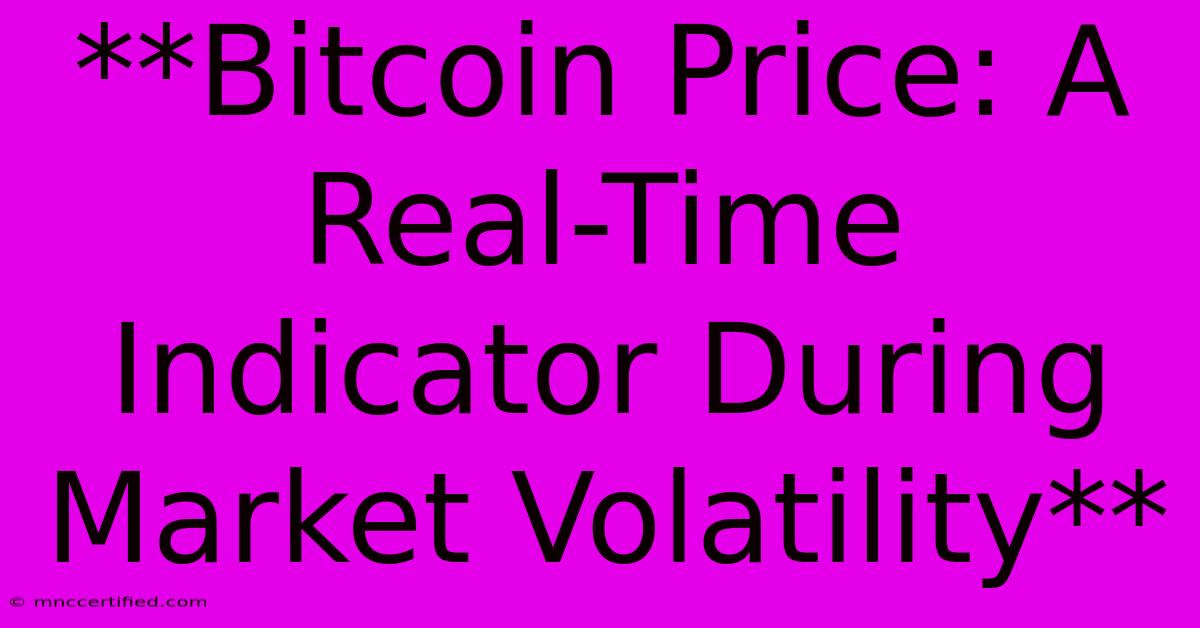**Bitcoin Price: A Real-Time Indicator During Market Volatility**

Table of Contents
Bitcoin Price: A Real-Time Indicator During Market Volatility
Bitcoin, the world's first and most prominent cryptocurrency, has gained immense popularity as a digital asset and a potential hedge against inflation. However, Bitcoin's price is notoriously volatile, often swinging wildly in response to a myriad of factors. This volatility, while a concern for some investors, also makes Bitcoin a powerful indicator of broader market sentiment.
Bitcoin as a Market Sentiment Barometer
Bitcoin's price often reflects investor sentiment across various asset classes. When the stock market is bullish, investors tend to be optimistic, driving up demand for risky assets like Bitcoin. Conversely, during market downturns, investors seek safer havens, leading to a sell-off in Bitcoin and other cryptocurrencies. This correlation between Bitcoin and traditional markets is a testament to the growing influence of cryptocurrencies in the global financial landscape.
Factors Influencing Bitcoin's Price Volatility
1. Macroeconomic Events: Major economic events like interest rate hikes, inflation reports, and geopolitical tensions significantly impact Bitcoin's price. For instance, during periods of high inflation, investors may turn to Bitcoin as a potential inflation hedge, leading to price increases.
2. Regulatory Developments: Government regulations and policies concerning cryptocurrencies can influence investor confidence and, in turn, Bitcoin's price. Favorable regulations often lead to increased adoption and price appreciation, while restrictive policies can dampen investor enthusiasm and cause price declines.
3. Market Sentiment: Investor sentiment plays a crucial role in Bitcoin's price fluctuations. News headlines, social media trends, and general market optimism or pessimism can influence the demand for Bitcoin, driving price movements.
4. Institutional Adoption: As more institutional investors, such as hedge funds and corporations, allocate capital to Bitcoin, it has a direct impact on its price. Increased institutional adoption signifies growing legitimacy and stability, potentially leading to higher valuations.
5. Technical Factors: Technical indicators and trading patterns can also influence Bitcoin's price. These factors include trading volume, price momentum, and support and resistance levels, which traders use to predict future price movements.
Utilizing Bitcoin as a Market Indicator
While Bitcoin's price volatility can be a challenge for short-term investors, it presents an opportunity for seasoned traders and market analysts to glean valuable insights. By tracking Bitcoin's price movements and understanding the underlying factors influencing them, investors can potentially:
- Identify Market Trends: Bitcoin's price can serve as an early indicator of market sentiment, potentially signaling upcoming shifts in traditional asset classes.
- Gauge Investor Confidence: A sharp rise in Bitcoin's price might indicate a surge in risk appetite among investors, while a decline could suggest a shift towards safer haven assets.
- Time Market Entries and Exits: By analyzing Bitcoin's price movements and its correlation with other markets, traders can potentially time their entry and exit points to maximize returns and minimize losses.
Conclusion
Bitcoin's volatile nature is not a disadvantage but rather a characteristic that makes it a powerful real-time indicator of market sentiment. By understanding the factors influencing Bitcoin's price and analyzing its correlation with other asset classes, investors can gain a valuable perspective on the broader market landscape. While it's essential to remember that Bitcoin's price is subject to various unpredictable factors, it remains a valuable tool for discerning market trends and making informed investment decisions.

Thank you for visiting our website wich cover about **Bitcoin Price: A Real-Time Indicator During Market Volatility**. We hope the information provided has been useful to you. Feel free to contact us if you have any questions or need further assistance. See you next time and dont miss to bookmark.
Featured Posts
-
Polymarket Whale Profits 48 Million On Trump
Nov 07, 2024
-
Uefa Champions League Inter Milan Vs Arsenal
Nov 07, 2024
-
Rosenbaum And Pearl Investment Banking Pdf
Nov 07, 2024
-
Trump Win Boosts Dogecoin Memecoin Market
Nov 07, 2024
-
Gary Barlows Son And Other Tall Celebrity Kids
Nov 07, 2024